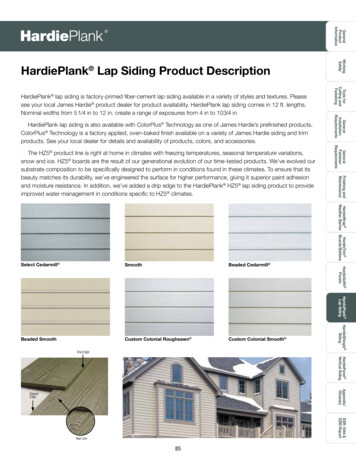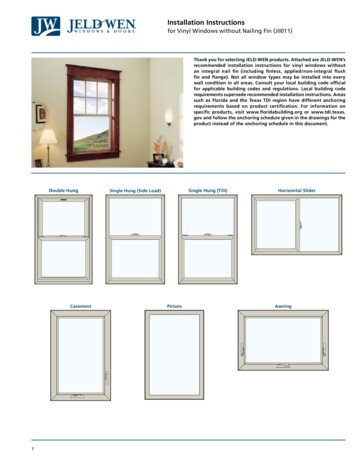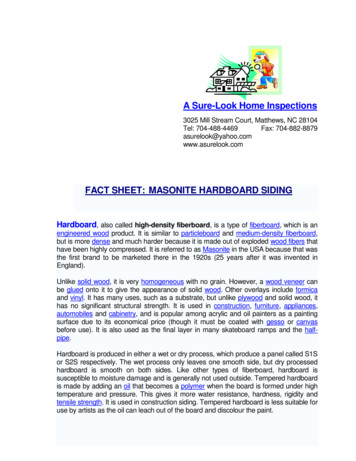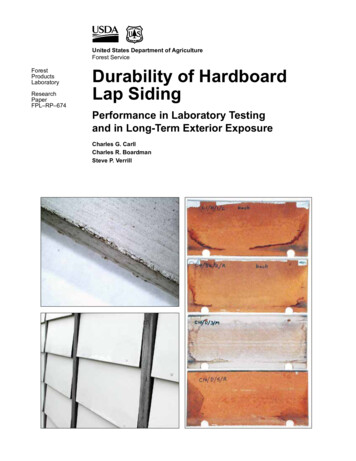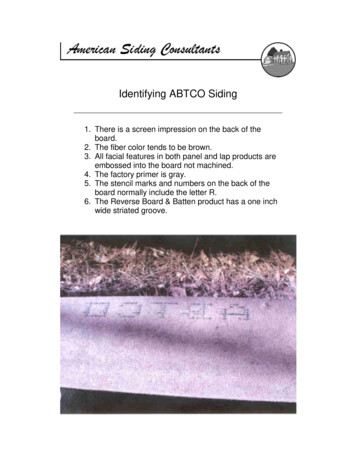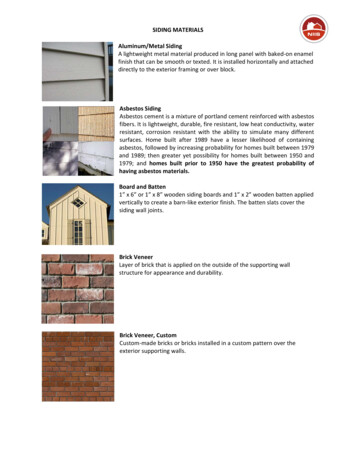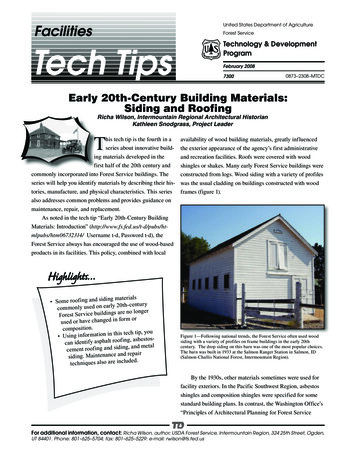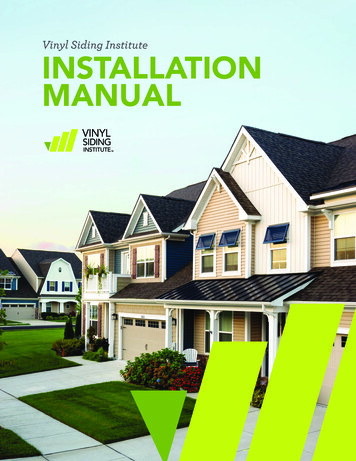
Transcription
Vinyl Siding InstituteINSTALLATIONMANUAL
This manual is published by the Vinyl Siding Institute, Inc. (VSI) as a service to the industry. VSImembers are manufacturers of vinyl siding and other polymeric siding and suppliers to the industry.The information provided in this publication is offered in good faith and believed to be reliable, but ismade without warranty, express or implied, as to merchantability, fitness for a particular purpose, orany other matter. VSI does not endorse the proprietary products or processes of any manufacturer.This publication is not intended to provide specific advice, legal or otherwise, on particularproducts or processes. Readers should consult with their own legal and technical advisors, vinylsiding suppliers, and other appropriate sources (including but not limited to product or packagelabels, technical bulletins, or sales literature) that contain information about known and reasonablyforeseeable health and safety risks of their proprietary products and processes. VSI, its members,and contributors do not assume any responsibility for the users’ compliance with applicable laws andregulations, nor for any persons relying on the information contained in this guide.Information about individual manufacturers’ products contained herein has been provided by thosemanufacturers, who are solely responsible for the accuracy and completeness of the data.Use of Manufacturers’ InstructionsSome specialized products may require unique installation instructions. Please contact themanufacturer directly for information about installing those products.Vinyl siding is engineered for easy installation. To make the process even easier, get helpthrough every step with our full vinyl siding installation videos at vinylsiding.org/installation.Videos are available in additional languages.For general information about vinyl siding, contact the Vinyl Siding Institute at:Vinyl Siding Institute1800 Diagonal Road, Suite 545Alexandria, VA 22314vinylsiding.orgCopyright 2020 The Vinyl Siding Institute, Inc. All rights reserved. No part of this work may be reproduced or used in any form or by any means-graphic,electronic, or mechanical, including photocopying, recording, taping, or information storage and retrieval systems-without the written permission of thecopyright owner, VSI. Users may download this manual to their own computers and make multiple machine-readable copies and/or print hard copies forpersonal use, as long as they do not alter, modify, adapt, display, publish, sell, or prepare derivative works based upon such material.
Build the life you wantBECOME A VSI CERTIFIEDVINYL SIDING INSTALLERWant to increase your skill level and receive marketing materials that will help improve your professionalpresence and grow your business? Register for a VSI Certified Installer class, in-person or online.Questions? Contact us at VSIsupport@databanque.com or call us at 877-627-8997 to find out more.NOTE: Vinyl siding installers with the required experience levels canbecome VSI Certified Installers if they successfully complete a course andpass a written examination. Certified Installers receive an identificationbadge and are listed on VSI’s website. For more information on theVSI Certified Installer Program, visit vinylsiding.org.
TABLE OF CONTENTSForeword. 1Horizontal Siding Installation. 21Installing Panels. 21Important Notes. 2Fitting Siding Around Fixtures. 22Building Codes. 2Fitting Under Windows. 22Installing for Wind Load Resistance. 3Sidewall Flashing at Roof Lines. 23Water-Resistive Barrier. 3Finishing at the Top of Walls. 24Storage. 4Optional Eave and Gable Treatment. 26Fire Safety Information. 4Re-siding Over Asbestos Siding. 4Vertical Siding and Accessories Installation. 27Historic Restoration. 4Preparation. 27Disposal/Recycling. 4Accessories. 27Basic Installation Rules. 5Window, Door, and Roof Trim. 28Cleanup. 6Sidewalls. 28Materials, Tools, and Accessories. 7Gable Ends. 30Specialty Siding. 30Panel Profiles. 7Basic Installation Tools and Equipment. 7Soffit Installation. 30Specialty Tools. 8Gable Peak Preparation. 31Accessories. 8Preparation. 31Getting Started. 9Wall Substrate Materials. 9Installation Over Open Eaves. 32Installation Over Enclosed Eaves. 34Porch Ceilings. 35How to Measure. 10Estimating Worksheet. 11Other Recommendations. 36Attaching Shutters andOther Specialty Products. 36Fastener Choices. 12Replacing a Damaged Panel. 36Nails. 12Repairing a Damaged Corner Post. 37Bending Trim Sheet. 38Fastening Procedure. 13Using Drawings. 38Cutting Siding. 14Measuring. 39Cutting and Bending. 40Preparing the Walls. 15Attaching Trim Sheet. 40Installing Trim with Built InInstalling Accessories. 16J-Channel Around Windows. 40Starter Strip. 17Windows, Doors, and Roof Lines. 18Terms to Know Appendix 1. 4 1J-Channel Over Roof Lines. 20Gable and Trim. 20Acronyms Appendix 2. 43Notes. 44Installation Manual
FOREWORDKnown for its outstanding performance, vinyl siding is the exterior cladding of choicefor homeowners, remodeling contractors, architects, and builders. Compared to othersiding products, vinyl is attractive, durable, easy to maintain, and cost-effective.Vinyl siding is available in a variety of architectural styles, eye-catching colors,and design-enhancing profiles, finishes, and textures.To ensure proper quality, vinyl siding must meet or exceed the requirements ofASTM D3679 Standard Specification for Rigid Poly (Vinyl Chloride) (PVC) Sidingand other applicable standards from ASTM International, including those regardingcolor retention. As a service to the industry, the Vinyl Siding Institute (VSI) sponsors aprogram that allows manufacturers to certify, with independent, third-party verification,that their siding meets or exceeds this specification. The program covers vinyl siding, aswell as polypropylene siding (certified to meet or exceed ASTM D7254) and insulatedvinyl siding (certified to meet or exceed ASTM D7793). Insulated vinyl siding is a typeof continuous insulation that provides a minimum R-value of R-2.0. Insulated vinyl sidingis widely accepted in energy efficiency programs and is defined in the InternationalEnergy Conservation Code. For a listing of certified products, see VSI’s website atvinylsiding.org. In addition, look for the appropriate certification labels on boxesof siding (Figure 1).This manual sets forth the basic guidelines for vinyl siding installation. The instructionsherein are based, in part, on ASTM D4756 Standard Practice for Installation of RigidPoly (Vinyl Chloride) (PVC) Siding and Soffit, the standard method for installation ofvinyl siding and soffit. Updated information has been added as necessary. Additionally,it is recommended that installers review local building codes and manufacturers’literature for variations that may apply to specific products and/or geographic areas.The siding manufacturer’s specific product installation instructions should be followedin the event of a conflict with general industry practice or guidance.The method of applying vinyl siding and soffit is essentially the same for newconstruction and re-siding. However, where there are differences, special instructionsfor new construction and re-siding are included, as well as recommendations forhistoric restoration projects. In all applications, care should be exercised to properlyprepare the structure. See the Basic Installation Rules and additional details throughoutthis manual for proper installation techniques.Polypropylene siding is an exterior cladding similar to vinyl siding; it should beinstalled according to the manufacturer’s instructions, as well as applicable localbuilding codes in your area.While this installation manual reflects generally accepted vinyl siding installationpractices at the time of publication, because of continuing advances in design andmaterials, it is particularly important to check manufacturer literature and currentbuilding code requirements for your area.1Installation ManualFigure 1
Important NotesBUILDING CODESInstallers need to be aware of building code requirements in the geographic areas where they are installing, and how thecodes relate to the instructions given in this manual and by the siding manufacturer. The requirements of local buildingcodes must always be observed, because they represent the legal requirements for an installation in a given jurisdiction.However, local codes are based on the national model building codes. Model codes themselves do not have the force oflaw until they are adopted by a state or local jurisdiction. In the United States, the primary source of model codes is theInternational Code Council, which publishes the International Building Code (IBC), International Residential Code (IRC),and International Energy Conservation Code (IECC). In Canada, the primary model code is the National Building Code ofCanada (NBC), published by the National Research Council of Canada.Most of the model building codes, and thus the local codes based on them, recognize that the product manufacturerusually knows how its product should be installed in order to provide best performance. Therefore, most building codesreference the manufacturer’s instructions and state that the product must be installed according to the code and themanufacturer’s instructions. However, any specific requirement in a local code will usually override any provision of themanufacturer’s instructions, especially if the local requirement is more restrictive. Therefore, vinyl siding installations mustalways conform to local building codes, but the local code may also require that the installation conform to the sidingmanufacturer’s instructions.The codes provide the greatest recognition to products that have been certified to a recognized standard by an approvedquality control agency. In fact, current editions of the IBC and IRC model codes require vinyl siding to be certified to ASTMD3679, polypropylene siding be certified to ASTM D7254, insulated vinyl siding be certified to ASTM D7793 (IRC only),and all to be verified by an approved quality control agency. As relevant editions of the model codes are adopted bylocal jurisdictions, code officials will want to verify that the siding is properly certified (which can usually be determined byidentifying the VSI certified product label on the box—see Figure 1 and that the installation conforms to the manufacturer’sinstructions. Always be sure that the instructions are available on the job site for an inspector to review.This manual is not a building code and it is not a substitute for the manufacturer’s instructions. However, it has beendeveloped by referencing the provisions of the model building codes, the requirements of ASTM D4756, and generallyaccepted installation practices within the vinyl siding industry. This manual therefore reflects the most common installationrequirements that apply to the vast majority of vinyl siding products. Use this manual to understand how vinyl sidingand soffit should generally be installed, but be prepared to comply with any differing provisions of local codes and themanufacturer’s instructions for a specific product.2Installation Manual: Important Notes
Important NotesINSTALLING FOR WIND LOAD RESISTANCEVinyl siding is remarkably resistant to high wind, given its light weight and relatively simple installation. But inorder for it to perform to its potential, it must first be properly selected, and then properly installed.All certified vinyl siding is tested for wind load resistance and must meet certain minimum requirements. Allpolymeric claddings certified under the VSI program are required to include standard design pressure rating forwind load labeling on either product itself or the packaging. The labeling shows the wind “performance-ability”of the products, so that code officials and other experts know that these are the right products for use in anygiven area. Be sure to consult with Architects, Code Officials or Building/Site Engineers about the design pressurerating required for the building prior to starting installation.Vinyl siding installers need to make sure that the siding is installed in a way that allows it to meet its rating. Theinstructions in this manual provide the minimum requirements for most vinyl siding products for most installationsituations. However, the manufacturer may have different instructions for their products, or they may havetheir own special installation requirements that apply in high-wind locations. Always consult the manufacturer’sinstructions before starting a vinyl siding installation.Design pressure testing has been in effect for the past 20 years, but in recent years, testing has distinguishedbetween coastal and non-coastal products with even more rigorous standards. Polymeric siding has improvedits resilience in direct relationship with code requirements and standards becoming more stringent. For moredetailed information on installing product in high wind coastal areas, please request a copy of How toProperly Install Polymeric Siding and Soffit in Coastal Areas.WATER-RESISTIVE BARRIERVinyl siding, insulated vinyl siding, and polypropylene siding are exterior claddings, not water-resistive barriers,and are designed to allow the material underneath to breathe. This factor provides a supplemental rainscreenthat reduces the amount of water that reaches an underlying water-resistive barrier.To achieve designed performance, and to comply with the most recent building codes, vinyl siding, insulatedvinyl siding, and polypropylene siding must be installed over a water-resistive barrier, which is intended toprevent liquid water that has penetrated behind the exterior covering from further intruding into the exterior wallassembly.Water-resistive barrier systems often consist of a combination of exterior cladding such as vinyl siding, insulatedvinyl siding or polypropylene siding, flashed wall openings and penetrations, water-resistive barrier material,and sheathing. Effective exterior wall systems will shed the water initially, control moisture flow by capillaryand diffusion action, and minimize absorption into the wall structure.The level of water resistance required is determined by the applicable building code, the structure, and theclimate. If correctly installed as required by code, certified polymeric siding can effectively withstand theelements. To find out more about I-CODE regulations, please request a current in-depth I-CODE guide fromVSI. Note that additional measures may provide increased protection against water intrusion than the minimumrequirements of the building code.3Installation Manual: Important Notes
Important NotesSTORAGEWhen transporting vinyl siding to a job site, make certain to keep the cartons flat and supported along theirentire length. At the job site, take the following precautions when storing vinyl siding cartons: Store the cartons on a flat surface and support the entire length of the cartons. Keep the cartons dry. Store the cartons away from areas where falling objects or other construction activity may cause damage. Do not store the cartons in stacks more than six boxes high, and make sure the stacks are stable. Do not store the cartons in any location where temperatures may exceed 130 F/54.4 C (e.g., on blacktoppavement during unusually hot weather or under dark tarps or plastic wraps without air circulation).FIRE SAFETY INFORMATIONVinyl siding is composed mainly of polyvinyl chloride, more commonly known as vinyl or PVC. Due to itschlorine base, vinyl siding is inherently flame-retardant. So, when it comes to fire safety, vinyl siding is arecognized material that meets or exceeds industry standards. All building materials should be installed inaccordance with local and state building code requirements.Please see the most recent Fire Safety fact sheet for more information.RE-SIDING OVER ASBESTOS SIDINGAsbestos siding is a regulated material, and the appropriate environmental agency or local building codeofficial should be contacted before re-siding over this product.HISTORIC RESTORATIONWhen using vinyl siding for historic restoration, please follow the historic governing commission’srecommendations on all requirements. Additionally, please review the siding manufacturer’s instructions andyour local building codes for variations that may apply.DISPOSAL/RECYCLINGDispose of all scrap or excess material in a manner that is consistent with local and state rules and regulations.PVC is a thermoplastic material that can be recycled; for more information, contact the siding distributor ormanufacturer about the availability of recycling programs.4Installation Manual: Important Notes
BASIC INSTALLATION RULESBefore getting started, it is important to review several rules of thumb forvinyl siding application. The following rules, which are repeated in this guide,are critical for proper vinyl siding installation:1.Installed panels and accessories must move freely from side to side.2. When installing a siding panel, push up from the bottom until the lock is fully engaged with thepiece below it. Without stretching the panel, reach up and fasten it into place.3.Fasten nails or other fasteners in the center of the nailing slots (see Figure 15).4.Do not force the panels up or down when fastening in position.5. Do not drive the head of the fastener tightly against the siding nail hem. Allow approximately1/32" (0.8mm) (about the thickness of a dime) clearance between the fastener head and thesiding panel. Make sure the panels can move freely back and forth. Drive fasteners straight andlevel to prevent distortion and buckling of the panel.6. Leave a minimum of 1/4" (6.4mm) clearance at all openings and stops to allow for normalexpansion and contraction. When installing in temperatures below 40 F/4.4 C, increaseminimum clearance to 3/8" (9.5mm).7. Do not caulk the panels where they meet the receiver of inside corners, outside corners, or J-trim.Do not caulk the overlap joints.8. Do not face-nail or staple through siding, except in very limited applications where the nail hemis removed and nail punch lock systems cannot be used. Vinyl siding expands and contracts withoutside temperature changes. Face-nailing can result in ripples in the siding.9. In re-siding, furring or removal of uneven original siding may be necessary; take appropriateactions to ensure a smooth and continuous surface.10. In new construction, avoid the use of green lumber as the underlayment. Keep in mind that sidingcan only be as straight and stable as what lies under it.11. The installation of specific products may differ in detail from the instructions given in this manual.Always follow the manufacturer’s instructions, using parts specified by the manufacturer,to ensure proper installation.5Installation Manual: Important Notes
CLEANUPThe beauty of vinyl siding is maintained with little effort. Although vinyl siding will get dirty, like anything exposed to theatmosphere, a heavy rain will do wonders to clean it. It's also possible to wash it down with an ordinary garden hose. If neitherrain nor hosing does a satisfactory job, follow these simple instructions:1. Use an ordinary, long-handled car washing brush. This brush has soft bristles, and the handle fastens onto the end of thehose. It allows the siding to be washed just like a car. Avoid using stiff bristle brushes or abrasive cleaners, which maychange the gloss of the cleaned area and cause the siding to look splotchy.2. To remove soot and grime found in industrial areas, wipe down the siding with a solution made up of the following: 1/3 cup (0.08 liter) powder detergent (e.g., Fab, Tide, or equivalent powder detergent)* 1 gallon (3.8 liters) water 2/3 cup (0.16 liter) powder household cleaner (e.g., Soilax, Spic & Span, or equivalent)*3. If mildew is a problem, use the solution previously mentioned, but add 1 quart (0.95 liter) liquid laundry bleach.4. When washing down the entire house, start at the bottom and work up to the top in order to prevent streaking.5. For stubborn stains, use the following chart:STAINCLEANERS*Bubble GumFantastik, Murphy’s Oil Soap, or solution of vinegar (30 percent) and water (70 percent)CrayonLestoil DAP (Oil-based caulk)Fantastik Felt-tip PenFantastik or water-based cleanersGrassFantastik, Lysol, Murphy’s Oil Soap, or Windex LipstickFantastik or Murphy’s Oil Soap Lithium GreaseFantastik, Lestoil, Murphy’s Oil Soap, or Windex Mold and MildewFantastik or solution of vinegar (30 percent) and water (70 percent)Motor OilFantastik, Lysol, Murphy’s Oil Soap, or Windex OilSoft Scrub PaintBrillo Pad or Soft Scrub PencilSoft Scrub RustFantastik, Murphy’s Oil Soap, or Windex TarSoft Scrub Top SoilFantastik, Lestoil, or Murphy’s Oil Soap * Cleaning materials are listed in alphabetical order.VSI does not endorse proprietary products or processes and makes no warranties for the products referenced herein. Reference to proprietary names is forillustrative purposes only and is not intended to imply that there are not equally effective alternatives.Follow the precautionary labeling instructions on the cleaning agent container.Protect shrubs from direct contact with cleaning agents.6Installation Manual: Important Notes
MATERIALS, TOOLS, AND ACCESSORIESPANEL PROFILESVinyl siding comes in a variety of shapes, textures,Vertical Optionsand colors, creating a wide array of looks forHorizontal Optionsdifferent houses. It is manufactured primarilyfrom durable polyvinyl chloride in several differentprofiles, including single, double, triple, vertical,and Dutch lap (Figure 2).TripleVerticalThere are also various types of vinyl soffitDoubleBoard and Batten(the material used to enclose the underside ofan eave or overhang). Soffit can be vented, solid,hidden vent, or a combination of solid andvented (Figure 3) and is designed to maximizeairflow, preventing moisture accumulationTripleVerticalDoubleBoard and Battenand heat buildup between the sidingSingleDouble Dutch LapFigure 2Soffit Optionsand the house.Solid or Hidden VentVented PerforatedVented BasketweaveFigure 3BASIC INSTALLATION TOOLS AND EQUIPMENTPower SawA bench or radial-arm power saw can speed the cutting ofthe siding or soffit. A fine-tooth plywood blade should beused with the blade installed in the reverse direction.Some applicators prefer a handheld power saw. In extremelycold weather, move the saw through the material slowlyto prevent chipping or cracking (Figures 4 & 5).Utility KnifeFigure 4Figure 5Figure 6NOTE: A saw blade set upin reverse direction shouldbe used only for cuttingvinyl. Do not attempt touse it on other materialssuch as wood, plywood, etc.Vinyl is easy to cut, trim, and score with a utility knife orscoring tool (Figure 6).Tin SnipsGood quality tin snips or compound aviation-type snipswill speed the cutting and shaping of the vinyl (Figure 6).7Installation Manual: Materials, Tools, and AccessoriesDouble Dutc
MATERIALS, TOOLS, AND ACCESSORIESSPECIALTY TOOLSField Forming BrakeThis tool can be used to field form aluminum trim sheet (Figure 7).Nail Hole Slot PunchOccasionally, it may be necessary to elongate a nail hem slot to hit a stud.The hole is elongated to allow for expansion and contraction (Figure 7).Snap Lock PunchA snap lock punch is used to punch lugs in the cut edges of siding to be used forField Forming Brakethe top or finishing course at the top of a wall, or underneath a window (Figure 7).Zip Lock (Unlocking) ToolRemove or replace a siding panel with the zip lock tool. Insert the curved end ofthe tool under the end of the panel and hook onto the back lip of the buttlock.Nail hole slotpunchTo disengage the lock, pull down and slide the tool along the length of theSnap lockpunchZip lock(unlocking) toolpanel. Use the same procedure to relock a panel (Figure 7).Figure 7ACCESSORIESOutside and Inside Corner PostsCorner posts are used to provide a finished edge at an inside or outside corner.The siding from adjoining walls fits neatly into the inside or outside corner postchannels. Appropriate widths of channel openings are available to accommodatevarious configurations of siding.Trim and MoldingUtility trimDouble utility trimDrip cap/flashingJ-channelStarter stripA complete line of accessories is used to give every installation a professionalappearance, while providing a water-resistive facade. Some accessories includetrim, starter strips, J-channels, F-channels, drip caps, utility trim, and doubleutility trim (Figure 8). Each of these accessories will be addressed inmore detail throughout this manual.Please reference the Design Guide on www.vinylsiding.org for furtherinformation and/or additional options regarding Architectural Design Options.Figure 88Installation Manual: Materials, Tools, and AccessoriesF-channel
GETTING STARTEDWALL SUBSTRATE MATERIALSSheathingVinyl siding should be applied over a sheathing that provides a smooth, flatsurface. Consult local building codes for sheathing requirements. Vinyl sidingmust never be applied directly to studs without sheathing. As an alternative,installation of specific types of drop-in contoured foam underlayments for variousstyles of vinyl siding are available.Sheathing NailabilityVinyl siding can be installed over common wood sheathings such as plywood,oriented strand board (OSB), or other materials (e.g., foam plastic insulatingsheathing). For specific information on use of various types of sheathing refer tothe most current version of the IRC.Water-Resistive BarrierVinyl siding should be installed over a continuous water-resistive barrier tostop the intrusion of incidental water. Refer to page 3 for more information onwater-resistive barriers. Check your local building code for requirements in yourgeographic area.FlashingCode-compliant flashing should be integrated with the water-resistive barrierand applied around windows, doors, corners, other openings and roof lines.9Installation Manual: Getting Started
GETTING STARTEDHOW TO MEASUREEstimating Required Materials Make houses can be broken down into shapes ofrectangles or triangles, or a combination of both. To estimate the amount of starter strip required, measurethe linear feet around the entire base of the house. The area to be sided can be determined bymeasuring the height and width of the house,including windows (Figure 9). Add siding to all material estimates to allow for waste,depending on the pitch of the roof and other housespecific factors. Total all of the measurements for the areas to besided. Windows and doors are not usually deducted.Including them will provide an allowance factorfor waste. If the windows and doors are extremelylarge (such as a garage or sliding glass doors), somedeductions can be made (Figures 10–12). To estimate the total pounds of fasteners requi
Vinyl siding is available in a variety of architectural styles, eye-catching colors, and design-enhancing profiles, finishes, and textures. To ensure proper quality, vinyl siding must meet or exceed the requirements of ASTM D3679 Standard Specification for Rigid Poly (Vinyl Chloride) (PVC) Siding
